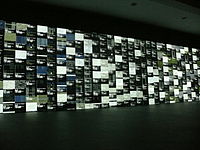
Photo from wikipedia
In 1928, in the apogee of historical modernity and with the modernist literary and artistic movement at its height, Edward L. Bernays, nephew of Sigmund Freud and a pioneer of… Click to show full abstract
In 1928, in the apogee of historical modernity and with the modernist literary and artistic movement at its height, Edward L. Bernays, nephew of Sigmund Freud and a pioneer of studies on the psychology of the masses, wrote a book called Propaganda to warn of the deliberate manipulation of popular opinion in the liberal democratic societies of the time. Almost 40 years later, the Frankfurt School, and in particular one of its most prominent members, Herbert Marcuse, who wrote One-Dimensional Man, pointed out the wrong direction taken by political and economic leaders, who had reduced people to simple commodities with exchange value and with no more existential references than those that came from mass media and advertising. At the time, the Second Vatican Council called for a shifting of the mindset towards humanisation and away from reification. Both philosophical or social and religious theories criticised the excesses and inequalities of the prevailing model of capitalist production, holding them up against the deprivations brought upon their own people by the socialist states of the time. Neither the supposed freedom of the former nor the equality of the latter was justifiable or acceptable. The 1970s then ushered in the poststructuralism of Jacques Derrida and Michel Foucault, changing the way in which reality was perceived and explained, how human development was understood and its most elemental relationships analysed. It pointed to language as a generative process and not as a mere communicative act. Neither Jean-François Lyotard in 1979 nor Gianni Vattimo in 1985 believed by then in the great rational and legitimising accounts of enlightened modernity, to the point that they drew attention to the enormous damage caused to civil populations during the bloody twentieth century. But neither modernity nor postmodernity, understood fundamentally as theoretical constructs and frameworks of reference and of complex philosophical and social analysis, have solved the main problems of humanity: lack of freedoms, prevailing inequality, poverty, loss of rights, manipulation, unfettered consumption and irresponsible pollution of the planet. In other words, we have created a world based on online communication, globalised yet isolated, heavily controlled, which makes us equals in all that is virtual and peripheral but differentiates us in all that is real and vital. It is a world with which we cannot keep pace and cannot therefore lay bare its contradictions. We are not, therefore, at the moment of the post but rather of the pre—a transformation that is pre-determined, pre-fabricated, pre-conceived, pre-mature... And what we need is a world that is more real (more solid in the words of Zigmunt Bauman), less speculative and much more united. If, moreover, it were to be guided by new ethical values, by knowledge, reflection, appropriate theoretical formulations, permanent criticism, civic dignity, social integration and an effort to put its results into practice, eschewing the commodification of knowledge and of people, we would be laying the foundations of future, renewed and, today more than ever, necessary pedagogical and educational proposals.
Journal Title: Educational Philosophy and Theory
Year Published: 2018
Link to full text (if available)
Share on Social Media: Sign Up to like & get
recommendations!